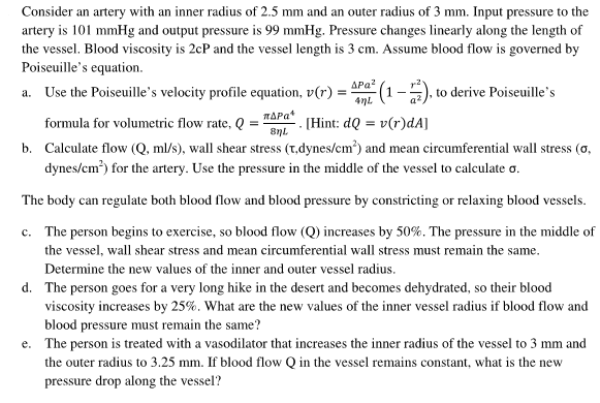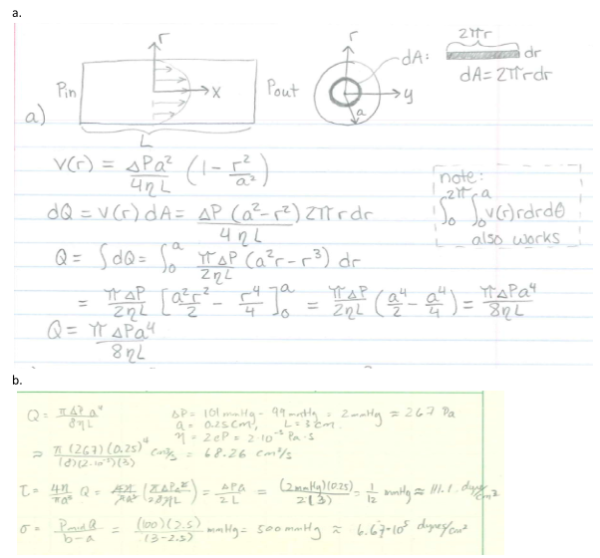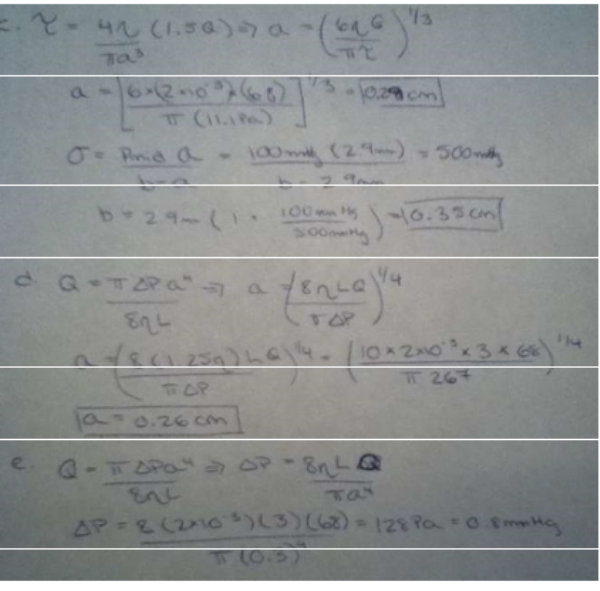Consider an artery with an inner radius of 2.5 mm and an outer radius of 3 mm. Input pressure to the artery is 101 mmHg and output pressure is 99 mmHg. Pressure changes linearly along the length of the vessel. Blood viscosity is 2cP and the vessel length is 3 cm. Assume blood flow is governed by Poiseulle's equation. a) Use Poiseuille's velocity profile equation to derive Poiseuille's formula for volumetric flow rate. b) Calculate flow, wall shear stress and mean circumferential wall stress for the artery. Use the pressure in the middle of the vessel to calculate sigma. c) The person begins to exercise, so blood flow increases by 50 percent. The pressure in the middle of the vessel, wall shear stress and mean circumferential wall stress must remain the same. Determine the new values of the inner and outer vessel radius. d) The person goes for a verly long hike in the desert and becomes dehydrated, so their blood viscosity increases by 25 percent. What are the new values of the inner vessel radius if blood flow and blood pressure must remain the same? e) The person is treated with a vasodilator that increases the inner radius of the vessel to 3 mm and the outer radius to 3.25 mm. If bloood flow Q in the vessel remains constant, what is teh new perssure drop along the vessel?
Highalphabet Home Page biomechanics biomechanics biomechaincs Page 1



Consider an artery with an inner radius of 2.5 mm and an outer radius of 3 mm. Input pressure to the artery is 101 mmHg and output pressure is 99 mmHg. Pressure changes linearly along the length of the vessel. Blood viscosity is 2cP and the vessel length is 3 cm. Assume blood flow is governed by Poiseulle's equation. a) Use Poiseuille's velocity profile equation to derive Poiseuille's formula for volumetric flow rate. b) Calculate flow, wall shear stress and mean circumferential wall stress for the artery. Use the pressure in the middle of the vessel to calculate sigma. c) The person begins to exercise, so blood flow increases by 50 percent. The pressure in the middle of the vessel, wall shear stress and mean circumferential wall stress must remain the same. Determine the new values of the inner and outer vessel radius. d) The person goes for a verly long hike in the desert and becomes dehydrated, so their blood viscosity increases by 25 percent. What are the new values of the inner vessel radius if blood flow and blood pressure must remain the same? e) The person is treated with a vasodilator that increases the inner radius of the vessel to 3 mm and the outer radius to 3.25 mm. If bloood flow Q in the vessel remains constant, what is teh new perssure drop along the vessel?
biomechanics page 1 biomechanics biomechanics biomechanics biomechanics biomechanics biomechanics biomechanics biomechanics page 2